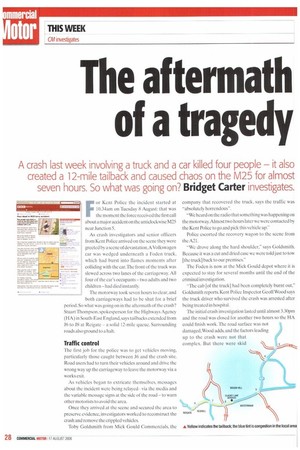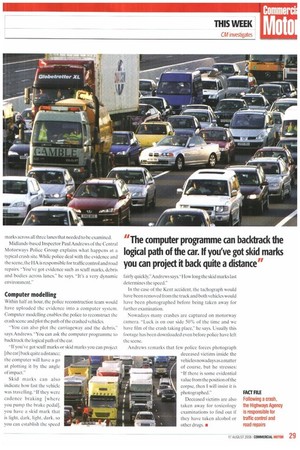The aftermath of a tragedy
Page 28

Page 29

If you've noticed an error in this article please click here to report it so we can fix it.
A crash last week involving a truck and a car killed four people — it also created a 12-mile tailback and caused chaos on the V125 for almost
seven hours. So what was going on? Bridget Carter investigates.
For Kent Police the incident started at 10.34am on Tuesday 8 August: that was the moment the force received the first call about a major accident on the anticlockwise M25 near Junction 5.
=MIN
As crash investigators and senior officers from Kent Police arrived on the scene they were greeted by a scene of devastation.A Volkswagen car was wedged underneath a Foden truck, which had burst into flames moments after colliding with the car. The front of the truck was stewed across two lanes of the carriageway. All four of the car's occupants two adults and two childrenhad died instantly.
i The motorway took seven hours to clear, and both carriageways had to be shut for a brief period. So what was going on in the aftermath of the crash? Stuart Thompson, spokesperson for the Highways Agency (HA) in South-East England, says tailbacks extended from J6 to J8 at Reigate a solid 12-mile queue. Surrounding roads also ground to a halt.
Traffic control The first job for the police was to get vehicles moving, particularly those caught between J6 and the crash site. Road users had to turn their vehicles around and drive the wrong way up the carriageway to leave the motorway via a works exit.
As vehicles began to extricate themselves, messages about the incident were being relayedvia the media and the variable message signs at the side of the road to warn other motorists to avoid the area.
Once they arrived at the scene and secured the area to preserve evidence, investigators worked to reconstruct the crash and remove the crippled vehicles.
Toby Goldsmith from Mick Gould Commercials, the company that recovered the truck, says the traffic was "absolutely horrendous".
"We heard on the radio that something was happening on the motorway. Almost two hours later we were contacted by the Kent Police to go and pick this vehicle up."
Police escorted the recovery wagon to the scene from the A21.
-We drove along the hard shoulder." says Goldsmith. Because it was a cut and dried case we were told just to tow [the truck] back to our premises."
The Foden is now at the Mick Gould depot where it is expected to stay for several months until the end of the criminal investigation.
"The cab [of the truck] had been completely burnt out," Goldsmith reports. Kent Police Inspector Geoff Wood says the truck driver who survived the crash was arrested after being treated in hospital.
The initial crash investigation lasted until almost 3.30pm and the road was closed for another two hours so the HA could finish work. The road surface was not dam aged,Wood adds, and the factors leading up to the crash were not that complex. But there were skid marks across all three lanes that needed to be examined.
Midlands-based Inspector Paul Andrews of the Central Motorways Police Group explains what happens at a typical crash site. While police deal with the evidence and the scene, the HA is responsible for traffic control and road repairs. "You've got evidence such as scuff marks, debris and bodies across lanes," he says. "It's a very dynamic environment."
Computer modelling
Within half an hour, the police reconstruction team would have uploaded the evidence into a computer system. Computer modelling enables the police to reconstruct the crash scene and plot the path of the crashed vehicles.
"You can also plot the carriageway and the debris," says Andrews. "You can ask the computer programme to backtrack the logical path of the car.
"If you've got scuff marks or skid marks you can project [the car] back quite a distance; the computer will have a go at plotting it by the angle of impact."
Skid marks can also indicate how fast the vehicle was travelling. "If they were cadence braking [where YOU pump the brake pedal]. you have a skid mark that is light, dark, light, dark, so you can establish the speed fairly quickly,"Andrews says."How long the skid marks last determines the speed."
In the case of the Kent accident, the tachograph would have been removed from the truck and both vehicles would have been photographed before being taken away for further examination.
Nowadays many crashes are captured on motorway camera. "Luck is on our side 50% of the time and we have film of the crash taking place," he says. Usually this footage has been downloaded even before police have left the scene.
Andrews remarks that few police forces photograph deceased victims inside the vehicles nowadays as a matter of course, but he stresses: "If there is some evidential value from the position of the corpse, then I will insist it is photographed."
Deceased victims are also taken away for toxicology examinations to find out if they have taken alcohol or other drugs. •










































































































































































































